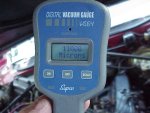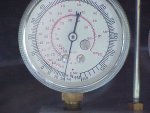IF you used a rented vacuum pump then always replace the oil in the pump for best results removing moisture from the system. Always shut off all valves (manifold gauges and valves at pump) BEFORE shutting down the pump.You are right, I did not think to detail the procedure I followed for recharging it. It had the hole in the evap when I purchased it, so we can probably assume it was like that long enough to where the system had reached 100% equilibrium with the outside.
Here's what I did (after installing new drier, evap and exp valve):
1. Pulled vacuum, left pump on for for almost 2h while doing this.
2. Turned pump off and closed system down to observe if it would hold negative pressure, waited 1h plus - no change.
3. Filled with nitrogen, and pulled vacuum again, times 4 (I was advised to do this by someone who works with ACs, but I admit I did not look up exactly what this would achieve, I just did it because it sounded like a good idea lol)
4. Finally recharged with the refrigerant, and I also put in a little dye and some PAG oil, which was mostly guesstimated yes. Refrigerant is R134a. 2.09 lbs (I weighed it, and tried to get as close to 2.09 lbs as possible as per tractors stated capacity).
It is definitely possible the compressor is corroded on the inside. In hindsight I wish I would have replaced it as well.
Today I ran it hot and then poured some cold water on the condenser. This had the effect of dropping the output temp from 80 to 60 in just 2-3 minutes. I don't know if this means the compressor is fine, or if it might still be the culprit (or one of the culprits).
Thanks!
If the system held vacuum (28inHg) or better then you were fine. If you purged the lines correctly...then there should not have been any significant amount of air introduced.
Sounds like you charged it correctly. If the compressor were weak or failing it would show as low pressure on both the low and high side.
IF you had a restriction, you would see higher than normal high side pressure and lower than normal low side pressure (even going into vacuum).
As previously mentioned I would turn my attention first to air flow issues. Make sure the fan belt (if belt driven) is tight and not slipping. Make sure all components (Radiator, Condenser, oil coolers) are clean and do not have the fins bent or dirty.
And most importantly.....check the fan shroud to see that air is not escaping around it and the radiator.



